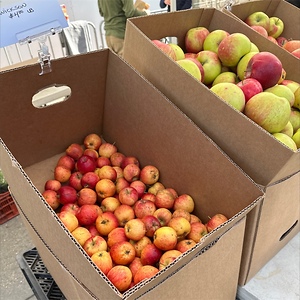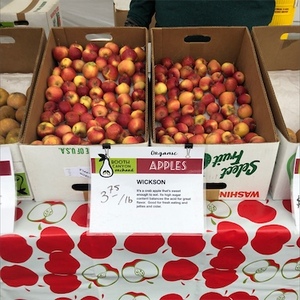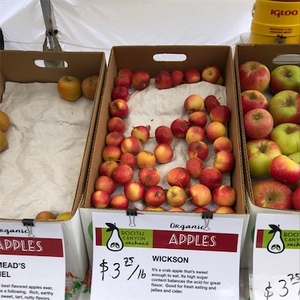


Wickson Crabapples
Estimated Inventory, lb : 0
Description/Taste
Wickson crabapples are round, flavorful fruits that grow on trees. They are relatively large for a crabapple, typically measuring about 2.5 to 5 centimeters in diameter. This variety has a round, slightly conical shape that is slimmer at the bottom than the top. They have a yellow-green base that develops rosy pink-red hues with sun exposure. Their skin is dotted with pale yellow lenticels and has a faint white residue on some areas of the fruit. At the top of the crabapple is a long, green-brown stem that’s set in a wide, russeted cavity while the bottom has a large calyx within a shallow, wrinkled indentation. Wickson crabapples' firm, white-yellow flesh has a juicy, slightly coarse texture and encases small brown seeds. This slightly spicy variety is abnormally sweet for a crabapple but still retains the tartness characteristic of this type of fruit.
Seasons/Availability
Wickson crabapples are available from early to mid-fall.
Current Facts
The botanical name for Wickson crabapples is Malus domestica and they are a member of the Rosaceae family along with plums, cherries, apricots, nectarines, and peaches. Wickson crabapples are a hybrid breed created in 1944 by Albert Etter, who initially claimed they were a cross between Newtown Pippin and Esopus Spitzenberg crabapples. Recent DNA tests have been unable to confirm the existence of either of these parent varieties, leading to the speculation that a different cultivar may have been used in the breeding of Wickson crabapples. For centuries, crabapples have been cultivated for making spirits and were once a key ingredient in wassail, a spiced cider traditionally consumed in English celebrations of health and longevity. Wickson crabapples are used to make fresh and hard ciders throughout the United States at distilleries in Oregon, New York, Montana, Pennsylvania, Virginia, and California.
Nutritional Value
The nutritional value of Wickson crabapples isn’t widely known, but crabapples in general are a good source of vitamin C. This nutrient encourages iron absorption, collagen production, infection defense, immune support, and cognitive and blood vessel function. This vitamin also helps lower blood pressure and prevents damage from free radicals and UV rays. Crabapples contain fiber, aiding in digestion, blood sugar regulation, appetite control, and colon, gut, and heart health. This fruit possesses polyphenols and flavonoids, antioxidants that may reduce inflammation and bad cholesterol levels. Historically, crabapples have been used to counteract the acidic effects of indigestion and gout.
Applications
Wickson crabapples can be eaten fresh out of hand, cooked, dried, fermented, pickled, or preserved in jams and jellies. Because they’re able to produce a large amount of juice from their small size, these fruits are a frequent ingredient in champagne ciders, meads, whiskeys, liqueurs, cocktails, and juices. When fresh, they pair well in salads with ingredients like arugula, celery, sweet potatoes, goat cheese, and walnuts. This variety may be baked into muffins, fritters, pancakes, pies, cakes, and zucchini breads. Wickson crabapples can be served alongside savory dishes like glazed chicken, pork chops, and stuffing. When dried, this variety is often converted into fruit leather, diced on top of yogurt parfaits and granola, or turned into dehydrated crabapple chips. They pair well with cranberries, grapes, apricots, plums, rose hips, pecans, chestnuts, caramel, white chocolate, ice cream, rosemary, and spinach. Wickson crabapples can be stored for up to 2 months in a cool, dry place.
Ethnic/Cultural Info
Wickson crabapples are named after Edward James Wickson, an influential Californian pomologist who was one of the few experts to recognize and support the inventor of this variety, Albert Etter. Wickson authored California Fruits, a seminal book on fruit cultivation in California released in the early 1900s. This influential work covers the state's most successful fruits and explains how they achieved high yields. The book discusses a variety of fruits, including pears, peaches, apricots, plums, cherries, citrus, grapes, and apples. In addition to telling readers how to successfully grow these varieties, California Fruits dives into the state’s history of fruit production and the positive fiscal impact it has had.
Geography/History
Wickson crabapples were developed in the Mattole Valley of Humboldt County, California by breeder Albert Etter in 1944. The crabapple species is native to the mountainous regions of Central Asia. They were spread throughout Europe and Asia on the Silk Road and were eventually brought to North America in the 18th century as a result of European colonial expansion. The Wickson crabapple variety grows in temperate regions with high sun exposure and moist soils. As a hybrid, they are not found in the wild and are instead grown in home gardens and produced commercially. The popularity of Wickson crabapples is mostly attributed to their use in ciders. Since crabapples remain a relatively niche fruit, the Wickson variety isn't widely available. It's most often found in North America at farmers’ markets or harvested from trees in orchards and private gardens.











